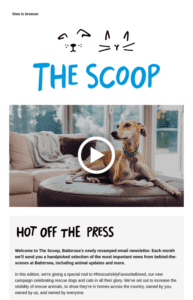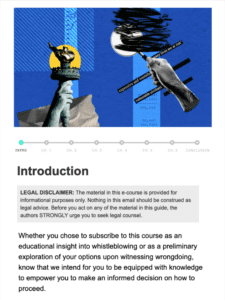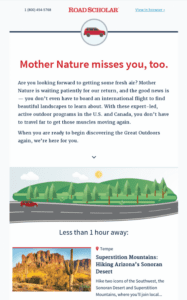A Comprehensive Guide to Nonprofit Email Marketing
- Why nonprofits need an email marketing strategy
- How to choose a nonprofit email marketing tool
- How to automate nonprofit email marketing
- 1. Define your email sequences
- 2. Build a robust and loyal email list
- 3. Personalize your messaging
- 4. Avoid the spam folder
- 5. Know when and how much to ask for
- 6. Segment the content you're sharing
- 7. Optimize for desktop, phone and tablets
- How to improve open rates for nonprofit emails
- 1. Gather the right information, every time
- 2. Streamline the list sign-up process
- 3. Deliver compelling and personalized messages
- 4. Focus on design to humanize these messages
- 5. A/B test and constantly monitor and improve this content against engagement
- Our top 3 nonprofit email campaigns
- Nonprofit email marketing FAQs
- How do I create a nonprofit email?
- How many emails should a nonprofit send per month?
- What is the best time to send a nonprofit email?
- What is a good email click through rate for nonprofits?
- Let us elevate your nonprofit email campaigns
If you’re working with a nonprofit, you’re probably always on the lookout for all the possible ways to keep your organization alive and thriving.
Enter email marketing, easily the most important promotional tool nonprofit organizations have at their disposal.
There are, however, a few key issues that nonprofits like yours face when it comes to running effective email marketing campaigns – tight staffing lines and even tighter budgets, for instance. So how do you stay in touch with key stakeholders without breaking the bank?
A consistent, targeted, and creative nonprofit email marketing strategy. With email, your organization can organically connect with supporters on a regular basis, which directly impacts your fundraising goals and community reach.

Why nonprofits need an email marketing strategy
Let’s start with the basics. Nonprofits are less focused on the immediate sale and more on the long-term relationships with their audiences that pay off in both donations and ambassadorship down the road.
That’s why email marketing can help your nonprofit build a loyal donor base that’s always engaged, caring and sharing.
The biggest virtue of email marketing is consistency. No one wants to receive an email asking for money every day during the week of #givingtuesday and then not hear from an organization again until next November. Your donors are worth more than that to you!
A clear, strategic plan for your nonprofit’s email marketing empowers you to connect with your audience often and authentically. (And with personalized and engaged messaging, a successful email campaign will drive more donations to your organization.)
How to choose a nonprofit email marketing tool
Before you even start to think about your strategy, messaging, or audiences, you need the right systems in place.
Email marketing tools can vary widely. A simple Gmail client allows you to send one-to-one messages, but you’ll likely need a more comprehensive marketing solution. That’s when CRM systems enter the equation.
5 best CRMs for nonprofit email marketing
CRM, short for customer relationship management, has become an invaluable part of email marketing today. It’s the connection between a customer database that stores valuable information about your individual contacts, and a communication tool designed for outreach.
Of course, there are hundreds of potential solutions on the market today. So how do you find the right one? More specifically, how can you find the best CRM tool not just for nonprofits in general, but your vertical and situation specifically?
The right tools are affordable on tight nonprofit budgets, and intuitive to use for staff that might not be marketing experts. They also have a comprehensive support system designed to train and improve your email marketing skills over time. Here is a great list of top nonprofit email marketing tools:
1. HubSpot
This tool shines in its ability to gather information about your contacts and leverage those into more segmented campaigns. (And they offer 40% off for nonprofits!)
2. MailChimp
They’re known for their intuitiveness and user-friendly interface. The templates are beautiful and can give you a running start.
3. Campaign Monitor
Far more in-depth and complex than its predecessors, this tool offers great reporting features. We’ll get into why those matters further down in this guide.
4. MailerLite
This is a highly straightforward tool that’s great if you’re just starting out. It’s almost impossible to get confused in its interface, but the tool lacks some advanced features of its competition.
5. SendGrid
This is a great tool for personalizing emails that speak directly to individual donors rather than larger segments of your audience.
How to automate nonprofit email marketing
So, you’ve found that email platform that works best for you. We love to hear it! Now, it’s time to start building your first campaign or, more specifically, set your strategy. Here’s what you need to consider.
1. Define your email sequences
Memorable email marketing efforts are never one-off messages. They’re always connected to a larger goal, whether that be welcoming new subscribers or encouraging loyalty among existing donors. Each of these sequences should be its own mini-campaign, consistent within itself and in the broader context in which it lives.
The first step in building a strategy is to think through what types of sequences you might need to build, and what they’ll look like:
- A welcome sequence for new subscribers, inviting them behind the scenes and allowing them to get to know your organization.
- A thank you sequence to new donors, showing your appreciation as well as how their donation will make an impact.
- An events-based sequence ahead of important dates, educating your audiences and encouraging them to register, and then thanking them for attending and sharing any post-event takeaways.
- A loyalty sequence designed to get lapsed donors back on your side. Emotional appeals and stories of how funds are utilized are helpful here.
- An end-of-year donation sequence created to capture audience donations at the busiest time in holiday giving.
These are just a few examples, of course. Each sequence should consist of anywhere between two and five emails, spaced out appropriately. They should be warm, personalized, and segmented only to the audience types that make the most sense for the situation.
2. Build a robust and loyal email list
The first step is to curate the right subscriber list – one less bent on quantity, more focused on quality of leads and engagement.
Subscribers can come from signing up on your website and socials, donor lists, event check-ins, and more. But no matter how they got there, your subscribers should make up a list of people who genuinely want to be there. A smaller list of truly-engaged volunteers, donors and community members is more important than a larger list of disengaged readers who are only too eager to send your latest story to the trash – or worse, the junk box.
3. Personalize your messaging
According to one study, personalized emails deliver six times higher transaction rates. Meanwhile, more than three-quarters of email marketers in one survey said their ROI tangibly improved when they used personalization tactics.
The good news is that with the right email marketing tool, it’s an easy thing to do. Personalization means leveraging your contacts’ information into the email you’re writing for them. You can do that on both the micro-level (like inserting their first name in the greeting line) and the macro-level (like segmenting emails according to your contacts’ shared preferences, actions, and backgrounds).
But it can get even simpler than that. For instance, making sure that your email comes from a person rather than a generic company account can build affinity among your audiences and makes them more likely to open the message.
4. Avoid the spam folder
After you’ve worked hard to build your list, the last thing you want is for your thoughtfully curated email newsletter to land in the spam folder.
There are some steps you can take to make sure your email reaches your subscribers:
- Know the anti-spam laws governing your audience.
- Make sure your subscribers are permission-based (meaning they signed up for your emails, have donated to your cause, or have become a member or your organization).
- Become a part of the address book. One surefire way to avoid the spam folder is for your subscriber to add you to their contact list. Set up a simple, text-based automated welcome, and make “add us as a contact” the only action item in the initial welcome email.
- Use restraint in the number of emails you send. Your emails may be marked as spam if subscribers feel that they receive too many. When choosing the amount of emails you send, think about your users first: what are their days like? How often can they dedicate real attention to this email? How much new and interesting content do we actually have to share that they find valuable? Once you answer those questions, you can start testing the number and frequency of emails in your drip campaign.
5. Know when and how much to ask for
Before making financial asks, it’s important for your nonprofit to build a connection with each new subscriber.
The simplest way to build this relationship is with an automated series of welcome emails sent every few weeks after a supporter joins your list. None of these first few emails should contain a request for a financial contribution – instead, slowly share more about your organization in each email.
Remember to avoid corporate anonymity – people want to feel connected to you and your organization’s work, so share the stories and people behind the organization as your welcome series unfolds.
6. Segment the content you’re sharing
Segmenting your email list is one of the most important steps you can take to make your nonprofit email marketing successful.
Say your nonprofit provides hot breakfast for those in need. You’ve been building an email contact list that includes interested community members, volunteers, donors, corporate partners, and other local nonprofits who partner with you for special events.
Really imagine someone from each of these groups. Does the weekly kitchen volunteer need the same message as the person who donated one time two years ago? Will the community liaison at the shelter across town respond to the same call to action as the community member who just joined your list?
No! Segmenting your list allows you to send emails to specific groups with tags like “volunteer” or “donor.” This will allow you to share the most relevant content with each group of supporters.
Make smart segmenting easy by integrating your email platform with your donor management software, database, or CRM.
You can also allow users to decide which kinds of emails they receive by allowing them to opt in or out of multiple types of communications such as event updates, newsletters, and campaigns for specific projects.
7. Optimize for desktop, phone and tablets
People read email on all sorts of platforms, including mobile. Therefore, your email campaigns must be responsive and easy to read on small screens.
Here are some ways to optimize for small screens:
- Keep subject lines short.
- Use clutter-free templates and minimal designs.
- Stay succinct: keep messages short and easy to read, with the most important content at the top.
- Break up paragraphs and avoid lengthy sentences. White space is your friend.
- Choose one or two striking images rather than cluttering the email with dozens of less impactful ones.
- Make your emails accessible by employing alt-text for images and headers, avoiding table layouts, and ensuring colored text has high contrast to increase readability.
How to improve open rates for nonprofit emails
You can email people all you want, but it won’t do much good unless they read them, right? Nonprofits on average have one of the highest open rates of any industry (26.6%), but that’s still only just over a quarter of all the emails that gets sent.
Here are some tips to make sure you’re doing everything you can to ensure your subscribers actually open your emails once they get them.
1. Gather the right information, every time
Supporters of your nonprofit organization can donate through multiple channels, including gifts sent via mail, event registrations, or online donations.
This can make keeping track of donor and subscriber information chaotic, but integrating donor and subscriber data within your email platform is key to your success.
Up-to-date and integrated data on your supporters will allow you to segment and personalize your content and measure the success of your nonprofit email marketing campaigns.
2. Streamline the list sign-up process
We’ve all had the experience of closing an internet window in frustration when the shopping cart doesn’t refresh properly or our form submission lands us on an error page.
For better or worse, people have become accustomed to fast and reliable user interfaces when browsing the web. Extraneous questions in an email sign-up form will deter some users from registering for your list.
Grow your subscriber base by keeping a simple, working sign-up form on your website and social media profiles.
3. Deliver compelling and personalized messages
Keep your organization’s mission and community impact at the heart of every communication.
Your audience cares about the work you are doing, so be sure to remind them why by telling the stories behind your organization.
With permission, you can use a story or photo from a community member who has benefited from your work to highlight a current campaign or call to action.
When crafting your emails, ask yourself questions such as:
- What has our organization done lately that we are proud of?
- What projects are we most excited about working on next?
If you’ve authentically connected to your supporters, chances are they’ll be proud and excited too.
4. Focus on design to humanize these messages
The design of your emails says a lot about your organization and its values. Check out the emails from organizations you follow (or the examples below) and notice how things like color choices, fonts, and overall design can change the tone of a message, and therefore, how you feel as you read.
No matter the feeling you’re trying to evoke in your audience, you’ll want to keep these guidelines in mind as you design:
- Avoid a cluttered email template. Opt for minimal, professional templates that highlight your organization and not the email medium itself.
- Craft a compelling headline that encourages clicks. A/B testing, discussed below, can help you learn what works best for your subscribers.
- Use subheadings and/or bullets to make your email easy to read.
- Use buttons in a contrasting color for calls to action.
- Employ images thoughtfully. Less is more!
5. A/B test and constantly monitor and improve this content against engagement
Most email service providers offer a suite of metrics for you to track engagement and performance of individual emails.
Keep an eye on open rates and click through rates. Note which of your emails perform best in these key areas to see what kinds of content your audience finds most interesting.
A/B testing subject lines is also a great option for fine tuning engagement. An A/B test allows you to send an email with two different subject lines to a small percentage of your list. The winning subject line is then used for the emails to the rest of the list. Note which subject lines “win” so you can craft more effective ones for future email campaigns.
Finally, be sure to monitor the donations your organization receives through email campaigns. Noting which types of content produce results allows you to tailor future communications for the best email marketing strategy.
Our top 3 nonprofit email campaigns
There are lots of different ways to engage your subscribers — your approach will vary depending on their needs and interests and on the unique character of your organization. That said, we’ve picked three of our favorite nonprofit email campaigns to inspire you with a sampling of the possibilities.
1. Battersea

Email example from Battersea on Really Good Emails
Established in the UK in 1860, Battersea, a multi-site animal shelter and advocacy organization, uses its cute yet informative email newsletter, The Scoop, to keep subscribers engaged.
Battersea understands that supporters care most about the adorable cats and dogs the organization saves every day. As a result, Battersea highlights rescue animals at every turn, with photos, personalized stories, and links to the org’s YouTube shows that follow the adventures of rescued pets.
In addition to heartwarming content, Battersea also integrates helpful information for pet owners in the forms of pet product reviews and guides.
Finally, Battersea includes a call for donations – but with a light touch. The call is formatted simply, and the monetary amount mentioned – 5 pounds – is small.
The button doesn’t say “donate” – instead, Battersea reminds you what you’re supporting, and even lets you identify as a cat or dog lover with the two different buttons: “Sponsor a Cat Cabin” and “Sponsor a Dog Kennel.” This is an organization that understands its audience.
2. Project on Government Oversight

Project on Government Oversight Email on Really Good Emails
As a nonpartisan watchdog for governmental corruption, the Project on Government Oversight (POGO) needs its email campaigns to reflect the serious tone and mission of the organization.
Through design and content choices, POGO communicates knowledge and expertise, positioning itself as a trustworthy organization.
The email featured above is the first in an informative series about the history and legal ramifications of whistle-blowing. Rather than telling subscribers about the organization’s work, this email series demonstrates the value of POGO by acting as an educational tool itself.
While this model is not appropriate for every type of nonprofit, we love how POGO uses email to creatively engage and educate.
If your nonprofit has an educational mission, consider including a series of educational emails as part of your overall nonprofit email marketing strategy. Readers who are interested in learning more about the issue you’re working on will deeply connect to your organization when you guide them through a complex topic with care, as POGO does.
3. Road Scholar

Example from Road Scholar on Really Good Emails
Road Scholar, a nonprofit that specializes in providing over 100,000 global, educational travel opportunities for adults, believes in the power of experiencing new places to foster growth.
In addition to consistently providing new travel experiences for adults over 50, Road Scholar focuses on assisting retirees and helping them stay active, no matter where they are.
This specific example of an email marketing campaign of theirs really leans into their audience’s post-pandemic pain point: how can one get out, stay active, keep their minds fresh and learn something new, all at once?
While this email marketing campaign is less driven toward donors and more toward potential travelers, it’s all-the-more effective in its accessible language, fun approach and solutions-based impact.
Nonprofit email marketing FAQs
How do I create a nonprofit email?
So long as your organization is already registered as a 501(c)(3), you can get started with Google for Nonprofits online: that will give you access to a number of tools including a Google nonprofit email account. It will also establish your eligibility to apply for Google Ad Grants.
How many emails should a nonprofit send per month?
Your nonprofit should send 2 – 4 emails per month. Too many more than that and you risk exhausting your subscribers – too many fewer and you’re giving up opportunities for appeals and continued engagement. As always, though, try to let your organization’s needs and your team’s bandwidth shape your approach.
What is the best time to send a nonprofit email?
According to Campaign Monitor, Mondays generally have the highest open rates and Tuesdays have the highest click-through rates. Weekends usually see the least engagement. But target demographics differ from one organization to another, so the best way to find out what works well for your nonprofit is to get to know your audience, run some tests, and gather your analytics.
What is a good email click through rate for nonprofits?
The average click-through rate for nonprofits in 2022 was 2.7% – that’s a little above the average for all industries, which was 2.3%. Nonprofit emails also generally have one of the highest open rates of any industry: 26.6% in 2022.
Let us elevate your nonprofit email campaigns
Big Sea speaks nonprofit: from grassroots community programs to mutual aid organizations and well-known national brands. We’ll help you see real results for your org and your community.
Contact us to start the conversation about effective and strategic email marketing for nonprofits, and to set your organization on the path of email (and digital) marketing success.



